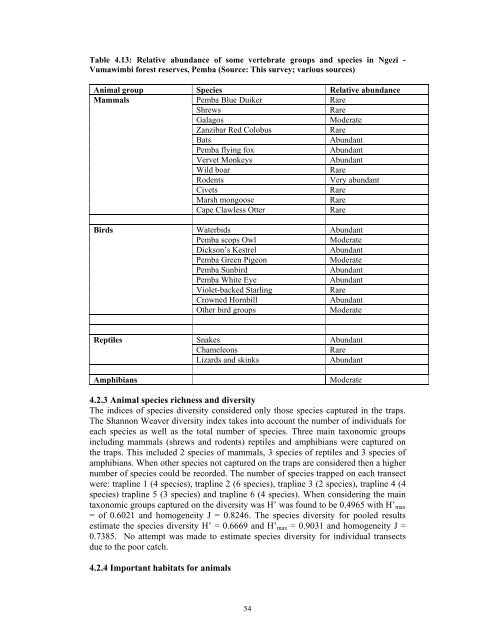serikali ya mapinduzi zanzibar care tanzania and department
serikali ya mapinduzi zanzibar care tanzania and department
serikali ya mapinduzi zanzibar care tanzania and department
You also want an ePaper? Increase the reach of your titles
YUMPU automatically turns print PDFs into web optimized ePapers that Google loves.
Table 4.13: Relative abundance of some vertebrate groups <strong>and</strong> species in Ngezi -<br />
Vumawimbi forest reserves, Pemba (Source: This survey; various sources)<br />
Animal group Species Relative abundance<br />
Mammals<br />
Pemba Blue Duiker<br />
Rare<br />
Shrews<br />
Rare<br />
Galagos<br />
Moderate<br />
Zanzibar Red Colobus<br />
Rare<br />
Bats<br />
Abundant<br />
Pemba flying fox<br />
Abundant<br />
Vervet Monkeys<br />
Abundant<br />
Wild boar<br />
Rare<br />
Rodents<br />
Very abundant<br />
Civets<br />
Rare<br />
Marsh mongoose<br />
Rare<br />
Cape Clawless Otter<br />
Rare<br />
Birds<br />
Waterbids<br />
Pemba scops Owl<br />
Dickson’s Kestrel<br />
Pemba Green Pigeon<br />
Pemba Sunbird<br />
Pemba White Eye<br />
Violet-backed Starling<br />
Crowned Hornbill<br />
Other bird groups<br />
Abundant<br />
Moderate<br />
Abundant<br />
Moderate<br />
Abundant<br />
Abundant<br />
Rare<br />
Abundant<br />
Moderate<br />
Reptiles<br />
Amphibians<br />
Snakes<br />
Chameleons<br />
Lizards <strong>and</strong> skinks<br />
Abundant<br />
Rare<br />
Abundant<br />
Moderate<br />
4.2.3 Animal species richness <strong>and</strong> diversity<br />
The indices of species diversity considered only those species captured in the traps.<br />
The Shannon Weaver diversity index takes into account the number of individuals for<br />
each species as well as the total number of species. Three main taxonomic groups<br />
including mammals (shrews <strong>and</strong> rodents) reptiles <strong>and</strong> amphibians were captured on<br />
the traps. This included 2 species of mammals, 3 species of reptiles <strong>and</strong> 3 species of<br />
amphibians. When other species not captured on the traps are considered then a higher<br />
number of species could be recorded. The number of species trapped on each transect<br />
were: trapline 1 (4 species), trapline 2 (6 species), trapline 3 (2 species), trapline 4 (4<br />
species) trapline 5 (3 species) <strong>and</strong> trapline 6 (4 species). When considering the main<br />
taxonomic groups captured on the diversity was H’ was found to be 0.4965 with H’ max<br />
= of 0.6021 <strong>and</strong> homogeneity J = 0.8246. The species diversity for pooled results<br />
estimate the species diversity H’ = 0.6669 <strong>and</strong> H’ max = 0.9031 <strong>and</strong> homogeneity J =<br />
0.7385. No attempt was made to estimate species diversity for individual transects<br />
due to the poor catch.<br />
4.2.4 Important habitats for animals<br />
54

















